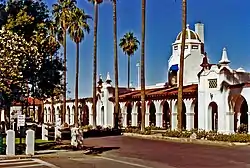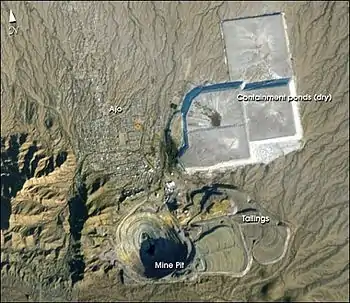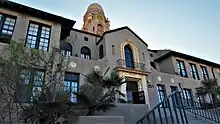Ajo | |
|---|---|
 Ajo plaza in 1990 | |
 Location in Pima County and the state of Arizona | |
| Coordinates: 32°22′53″N 112°52′10″W / 32.38139°N 112.86944°W | |
| Country | United States |
| State | Arizona |
| County | Pima |
| Area | |
| • Total | 33.33 sq mi (86.32 km2) |
| • Land | 33.33 sq mi (86.32 km2) |
| • Water | 0.00 sq mi (0.00 km2) |
| Elevation | 1,759 ft (536 m) |
| Population (2020) | |
| • Total | 3,039 |
| • Density | 91.19/sq mi (35.21/km2) |
| Time zone | UTC-7 (MST (no daylight saving time)) |
| ZIP code | 85321 |
| Area code | 520 |
| FIPS code | 04-00870 |
| GNIS feature ID | 0000538 |
.jpg.webp)

Ajo (/ˈɑːhoʊ/ AH-hoh) is an unincorporated community in Pima County, Arizona, United States. It is the closest community to Organ Pipe Cactus National Monument. The population was 3,304 at the 2010 census. Ajo is located on State Route 85 just 43 miles (69 km) from the Mexican border.
History
Ajo is the Spanish word for garlic (Spanish pronunciation: [ˈaxo]). The Spanish may have named the place using the familiar word in place of the similar-sounding O'odham word for paint (oʼoho). The Tohono O'odham people obtained red paint pigments from the area.
Native Americans, Spaniards, and Americans have all extracted mineral wealth from Ajo's abundant ore deposits. In the early nineteenth century, there was a Spanish mine nicknamed "Old Bat Hole" that was abandoned due to Indian raids. Tom Childs, Sr., found the deserted mine complete with a 60-foot (18 m) shaft, mesquite ladders, and rawhide buckets in 1847. He did not stay long at that time, because he was on his way to the silver mines near Magdalena de Kino, Sonora.
Thirty-five years later, Childs and his son returned with a friend and started developing the abandoned mine.
In the year 1884, the camp at Ajo was practically abandoned. Not a soul was in camp when Tom Childs Sr., and his son arrived. With them was Washington Michael Jacobs of Tucson, Arizona ... Childs and Jacobs located the mining claim which constituted most of the old Ajo group of mines. They made a permanent camp and worked the mines.[2]
High-grade native copper made Ajo the first copper mine in Arizona. Soon the Arizona Mining & Trading company, formed by Peter R. Brady, a friend of Childs, worked the rich surface ores, shipping loads around Cape Horn for smelting in Swansea, Wales, in the mid-1880s. The mine closed when a ship sank off the coast of Patagonia. Long supply lines and the lack of water discouraged large mining companies
With the advent of new recovery methods for low-grade ore, Ajo boomed. In 1911, Col. John Campbell Greenway, a Rough Rider and star Yale athlete, bought the New Cornelia mine from John Boddie. He became general manager of the Calumet and the Arizona mining company and expanded it on a grand scale. The Tucson, Cornelia and Gila Bend Railroad was built from Gila Bend to serve the mining industry and was in service from 1916 to 1985. In 1921, Phelps Dodge, the nation's largest copper company, bought New Cornelia and the mine became the New Cornelia Branch of Phelps Dodge, managed by Michael Curley. For several decades more than 1,000 employees worked for Phelps Dodge in the open pit mine. In 1983 union-affiliated mine employees went on strike. The mine continued with non-union labor for a short while before stopping production in 1985.[3]
The town was originally segregated, with neighborhoods called Indian Village and Mexican Town for the non-white residents.[4] Ajo is home to many retired people, Border Patrol agents, and young families.
During the construction of a new border wall in 2019–2020, many workers lived in the RV parks, hotels and rental houses.[5]
Geography
According to the United States Census Bureau, the census-designated place has a total area of 28.1 square miles (72.8 km2), all land. The census definition of the area was created by the Census Bureau for statistical purposes and may not precisely correspond to local understanding of the area with the same name. Ajo is located in the Little Ajo Mountains.
Plants of the Sonoran Desert thrive around Ajo, including saguaros and ocotillos. The Ajo lily or desert lily, an onion-like plant, also grows in the area.
The mineral ajoite was first found at the New Cornelia Mine, Ajo.[6] The rare mineral papagoite was also first described in the New Cornelia mine.[7]
Climate
This area has a large amount of sunshine year round due to its stable descending air and high pressure. According to the Köppen Climate Classification system, Ajo has a hot desert climate, abbreviated BWh on climate maps.[8] Rainfall is very low except during occasional monsoonal or frontal incursions, and is especially minimal between April and June. Since 1914 the wettest calendar year has been 1946 with 15.33 inches (389 mm) – including a record daily fall of 4.15 inches (105 mm) on 18 September – and the driest 1928 with 3.33 inches (85 mm).[9] Temperatures are very hot from April to October and mild to warm from November to March, with extremes ranging from 17 °F (−8 °C) on January 22, 1937 during that month's record Western cold wave, to 120 °F (49 °C) on July 20, 2023.[10]
| Climate data for Ajo, Arizona (1991–2020 normals, extremes 1915–present) | |||||||||||||
|---|---|---|---|---|---|---|---|---|---|---|---|---|---|
| Month | Jan | Feb | Mar | Apr | May | Jun | Jul | Aug | Sep | Oct | Nov | Dec | Year |
| Record high °F (°C) | 85 (29) |
92 (33) |
98 (37) |
105 (41) |
111 (44) |
119 (48) |
120 (49) |
118 (48) |
115 (46) |
109 (43) |
98 (37) |
88 (31) |
119 (48) |
| Mean maximum °F (°C) | 79.0 (26.1) |
82.5 (28.1) |
89.7 (32.1) |
97.4 (36.3) |
103.4 (39.7) |
110.4 (43.6) |
112.3 (44.6) |
111.0 (43.9) |
107.5 (41.9) |
100.4 (38.0) |
88.9 (31.6) |
79.2 (26.2) |
113.2 (45.1) |
| Mean daily maximum °F (°C) | 67.5 (19.7) |
70.5 (21.4) |
77.1 (25.1) |
84.0 (28.9) |
92.0 (33.3) |
101.1 (38.4) |
103.8 (39.9) |
103.0 (39.4) |
99.1 (37.3) |
89.2 (31.8) |
77.4 (25.2) |
66.6 (19.2) |
85.9 (29.9) |
| Daily mean °F (°C) | 56.2 (13.4) |
59.2 (15.1) |
64.5 (18.1) |
70.7 (21.5) |
78.8 (26.0) |
87.5 (30.8) |
91.7 (33.2) |
91.1 (32.8) |
86.8 (30.4) |
76.7 (24.8) |
64.2 (17.9) |
55.0 (12.8) |
73.5 (23.1) |
| Mean daily minimum °F (°C) | 44.9 (7.2) |
47.8 (8.8) |
51.8 (11.0) |
57.3 (14.1) |
65.5 (18.6) |
74.0 (23.3) |
79.7 (26.5) |
79.2 (26.2) |
74.4 (23.6) |
64.2 (17.9) |
51.0 (10.6) |
43.4 (6.3) |
61.1 (16.2) |
| Mean minimum °F (°C) | 34.6 (1.4) |
37.3 (2.9) |
40.9 (4.9) |
44.5 (6.9) |
52.9 (11.6) |
62.2 (16.8) |
70.1 (21.2) |
69.8 (21.0) |
63.7 (17.6) |
50.9 (10.5) |
40.2 (4.6) |
34.3 (1.3) |
31.9 (−0.1) |
| Record low °F (°C) | 17 (−8) |
22 (−6) |
27 (−3) |
33 (1) |
31 (−1) |
44 (7) |
58 (14) |
52 (11) |
41 (5) |
32 (0) |
30 (−1) |
22 (−6) |
17 (−8) |
| Average precipitation inches (mm) | 0.69 (18) |
0.80 (20) |
0.76 (19) |
0.17 (4.3) |
0.10 (2.5) |
0.08 (2.0) |
0.63 (16) |
1.43 (36) |
0.81 (21) |
0.44 (11) |
0.45 (11) |
0.62 (16) |
6.98 (176.8) |
| Average snowfall inches (cm) | 0.1 (0.25) |
0.0 (0.0) |
0.0 (0.0) |
0.0 (0.0) |
0.0 (0.0) |
0.0 (0.0) |
0.0 (0.0) |
0.0 (0.0) |
0.0 (0.0) |
0.0 (0.0) |
0.0 (0.0) |
0.0 (0.0) |
0.1 (0.25) |
| Average precipitation days (≥ 0.01 in) | 2.2 | 2.7 | 2.1 | 0.9 | 0.6 | 0.4 | 2.9 | 4.6 | 2.1 | 1.4 | 0.8 | 2.5 | 23.2 |
| Average snowy days (≥ 0.1 in) | 0.1 | 0.0 | 0.0 | 0.0 | 0.0 | 0.0 | 0.0 | 0.0 | 0.0 | 0.0 | 0.0 | 0.0 | 0.1 |
| Source: National Oceanic and Atmospheric Administration[10][11] | |||||||||||||
Demographics
| Census | Pop. | Note | %± |
|---|---|---|---|
| 1920 | 2,336 | — | |
| 1930 | 4,571 | 95.7% | |
| 1950 | 5,817 | — | |
| 1960 | 7,049 | 21.2% | |
| 1970 | 5,881 | −16.6% | |
| 1980 | 5,189 | −11.8% | |
| 1990 | 2,919 | −43.7% | |
| 2000 | 3,705 | 26.9% | |
| 2010 | 3,304 | −10.8% | |
| 2020 | 3,039 | −8.0% | |
| source:[12] | |||
.jpg.webp)

Ajo first appeared on the 1920 U.S. Census as (Pima County) Ajo Precincts Number 1 (pop. 2,040) and 2 (pop. 296).[13] In 1930, it simply appeared as the Ajo Precinct. It featured a White racial plurality in the latter census.[14] With the combination of all county precincts into 3 districts in 1940, it did not formally appear again until 1950, when it reported as an unincorporated village. In 1980, it was designated a census-designated place (CDP).
At its peak population in 1960 (7,049), it was the second-largest community in Pima County behind Tucson. In both 1950 and 1960, it was the 16th largest community in Arizona.[15]
As of the census[16] of 2000, there were 3,705 people, 1,659 households, and 1,088 families residing in the CDP. The population density was 132.0/sq mi (51.0/km2). There were 2,485 housing units at an average density of 88.5/sq mi (34.2/km2). The racial makeup of the CDP was 78.7% White, 0.2% Black or African American, 6.9% Native American, 0.3% Asian, 0.1% Pacific Islander, 9.2% from other races, and 4.6% from two or more races. 37.6% of the population were Hispanic or Latino of any race.
There were 1,659 households, out of which 19.7% had children under the age of 18 living with them, 51.4% were married couples living together, 10.6% had a female householder with no husband present, and 34.4% were non-families. 30.1% of all households were made up of individuals, and 17.1% had someone living alone who was 65 years of age or older. The average household size was 2.23 and the average family size was 2.74.
In the CDP the population was spread out, with 20.6% under the age of 18, 4.9% from 18 to 24, 17.2% from 25 to 44, 25.3% from 45 to 64, and 32.1% who were 65 years of age or older. The median age was 52 years. For every 100 females, there were 90.3 males. For every 100 females age 18 and over, there were 88.3 males.
The median income for a household in the CDP was $25,618, and the median income for a family was $29,310. Males had a median income of $28,000 versus $18,571 for females. The per capita income for the CDP was $14,548. About 16.5% of families and 22.3% of the population were below the poverty line, including 36.5% of those under age 18 and 9.0% of those age 65 or over.
Education
Ajo Unified School District is the only regular school district in Ajo, Arizona. The CDP is in Pima County Joint Technical Education District's 3rd Governing Board District. An elementary school, middle school, and high school are located on the same campus.
Public Safety
The CDP is served by the Pima County Sheriff's Department's Ajo District, Ajo Ambulance and the Ajo-Gibson Volunteer Fire Department.
References
- ↑ "2020 U.S. Gazetteer Files". United States Census Bureau. Retrieved October 29, 2021.
- ↑ Rose, Dan, 1936, The Ancient Mines of Ajo, Mission Publishing, Tucson, AZ
- ↑ "History of Ajo | Ajo, Arizona". Retrieved October 21, 2021.
- ↑ Fallows, Deborah (March 30, 2015). "An Open-Pit Mining Town Finds a Second Life". The Atlantic. Retrieved December 31, 2019.
- ↑ Gilbert, Samuel (April 16, 2020). "Pandemic fears in border towns as workers flock in to build Trump's wall". The Guardian. ISSN 0261-3077. Retrieved May 1, 2020.
- ↑ "Ajoite". www.mindat.org.
- ↑ "Papagoite". www.mindat.org.
- ↑ "Ajo, Arizona Weather". Weatherbase.
- ↑ Western Regional Climate Center; Ajo, AZ, Precipitation Summary
- 1 2 "Ajo, AZ Weather". National Oceanic and Atmospheric Administration. 2021. Retrieved August 23, 2021.
- ↑ "U.S. Climate Normals Quick Access – Station: Ajo, AZ". National Oceanic and Atmospheric Administration. Retrieved February 16, 2023.
- ↑ "Census of Population and Housing (1790–2000)". U.S. Census Bureau. Retrieved July 17, 2010.
- ↑ Bureau of the Census Library (1924). "Fourteenth Census of the United States - State Compendium - Arizona" (PDF). Government Printing Office.
- ↑ "Arizona - Composition and Characteristics" (PDF). United States Census Bureau. 1930. pp. 141–163.
- ↑ "General Population Characteristics - Arizona" (PDF). United States Census Bureau. 1960.
- ↑ "U.S. Census website". United States Census Bureau. Retrieved January 31, 2008.
